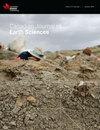北山脉萨德伯里陨石坑的形态和构造变化
IF 1.6
4区 地球科学
Q3 GEOSCIENCES, MULTIDISCIPLINARY
引用次数: 1
摘要
北山脉萨德伯里火成岩复合体(SIC)的基底接触被解释为陨石撞击坑的外缘。然而,SIC的底座、SIC内部的触点和上覆的Onaping都不是圆形的。它们的轮廓是椭圆形的。这一点和其他尚未得到充分解释的北岭地质细节包括:变质接触光圈宽度的变化,黑岩和花岗岩单元厚度的横向不连续变化,古地磁证据表明,碳化硅北岭接触最初有一个约200度的倾角,以及黑岩/辉长岩与花岗岩的磁性结构不同。有几个指标被用来确定北山脉目前的轮廓有多少是撞击后变形的结果,有多少是与陨石撞击有关的主要特征。利用马塔切万辉绿岩岩脉方位、岩相分析、古地磁和磁组构分析等资料,建立了塔里木盆地北段不同段的隆升、旋转和平移特征。这些分析表明:a)北岭的椭圆形状是与近圆形陨石坑相关的主要特征;b)一些原始陨石坑壁一定被保留下来;c)北岭的变形仅限于区域尺度的块体旋转,产生了一个西南倾向,由少量块体旋转倾斜和垂直位移引起的北西北走向的断层。本文章由计算机程序翻译,如有差异,请以英文原文为准。
Morphology and Tectonic modification of the Sudbury Impact Crater - The North Range
The basal contact of the Sudbury Igneous Complex (SIC) on the North Range is interpreted as the outer edge of a meteorite impact crater. Yet, the base of the SIC, and contacts within the SIC, and the overlying Onaping are not circular. Their outline is elliptical. This and other details of the geology of the North Range which have not been fully explained include: variations in the width of the metamorphic contact aureole, lateral discontinuous variations in the thickness of the norite and granophyre units, paleomagnetic evidence that the North Range contact of the SIC originally had a dip of around 20o, and differing magnetic fabrics in the norite / gabbro versus the granophyre. Several metrics are used to determine how much of the current outline of the North Range is the result of post-impact deformation and how much is a primary feature related to a meteorite impact. Uplift, rotation, and translation experienced by different segments of the North Range of the SIC is established using, dyke azimuth and petrographic analysis of Matachewan diabase dykes, and paleomagnetic and magnetic fabric data analysis. These analyses show: a) the elliptical form of the North Range is a primary feature associated with a near circular impact crater, b) some of the original crater wall must have been preserved, and c) deformation of the North Range is limited to regional scale block rotation producing a SW dip modified by minor block rotation tilting and vertical displacement associated with north-northwest trending faults.
求助全文
通过发布文献求助,成功后即可免费获取论文全文。
去求助
来源期刊

Canadian Journal of Earth Sciences
地学-地球科学综合
CiteScore
2.80
自引率
7.10%
发文量
66
审稿时长
6-12 weeks
期刊介绍:
The Canadian Journal of Earth Sciences reports current research in climate and environmental geoscience; geoarchaeology and forensic geoscience; geochronology and geochemistry; geophysics; GIS and geomatics; hydrology; mineralogy and petrology; mining and engineering geology; ore deposits and economic geology; paleontology, petroleum geology and basin analysis; physical geography and Quaternary geoscience; planetary geoscience; sedimentology and stratigraphy; soil sciences; and structural geology and tectonics. It also publishes special issues that focus on information and studies about a particular segment of earth sciences.
 求助内容:
求助内容: 应助结果提醒方式:
应助结果提醒方式:


